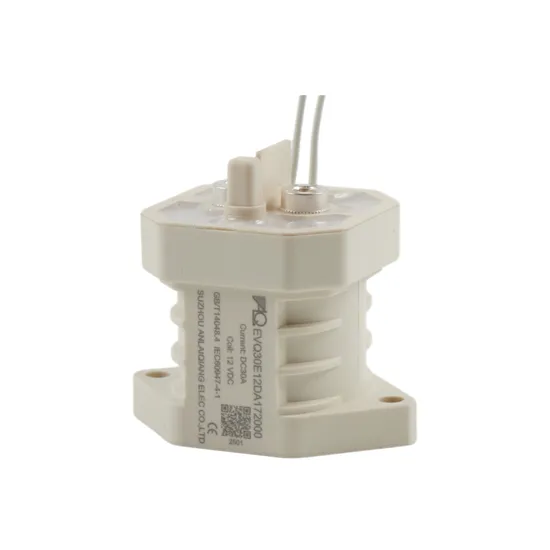
High Voltage Epoxy Encapsule DC Contactor for Energy Storage Equipment
| US$8.07-13.46 | 100 Pieces (MOQ) |
Basic Info.
Model NO.
EVQ30E12DA172000
Phase
1
Main Circuit Rating Voltage
1000V
Main Circuit Rating Current
30
Type
Dc Contactors
Power Contact Polar
Non-Polarized
Rated Operatinge Voltage
1,000V DC
Max.Continuous Current(at 23ºC)
30A
Coil Voltage
12V DC
Transport Package
Carton
Specification
120g
Trademark
ALQ
Origin
Suzhou
HS Code
8536410000
Production Capacity
50000pieces/Year
Packaging & Delivery
Package Size
40.00cm * 38.50cm * 11.50cm
Package Gross Weight
9.500kg
Product Description
Product Description FeaturesEpoxy packaging, the contacts are protected by nitrogen, preventing oxidation, strong cooling arc capacity.
High-voltage, high-current control capable.
Compact & low operating sound.
Safety and high contact reliability.
Can be installed in any direction.
Not freezing and condensing at low temperature.
Certification
CE
TUV
Applications
Pre-charge
Energy storage equipment
Power battery system
High voltage inverter
Power contact
| Parameter | Data |
| Contact arrangement | 1 Form X(SPST-NO-DM) |
| Contact polar | Without polarity |
| Power contact material | Copper or silver alloy optional, see "Part numbering system" |
| Rated operating voltage | 1,000V DC |
| Max. Continuous current(at 23ºC) | 30A |
Certifications
Exhibition
FAQ Q1: Are you trading company or manufacturer ?
We are a manufacturer.
Q2:What can you do if the product is broken?
Our products come with a one-year warranty from the date of acceptance. If any part breaks within this period and cannot be repaired, we will replace it with a new one. Please note that you will need to cover the shipping costs. After the warranty period, we can negotiate solutions and provide lifetime technical support for our equipment.
Q3:Why should we choose your company?
1. Our company is certified with CE, TUV, UL, RoHS, and IATF16949:2016, among others.
2. We offer advanced technical support and maintain a strict quality management system.
3. We provide efficient and timely service through email, WhatsApp, Facebook, and other channels.
Q4:What is the difference between an epoxy contactor and a ceramic contactor? 1. The sealed materials and processes differ: epoxy contactors use epoxy resin and require a baking process, while ceramic contactors use technical ceramics and require laser brazing. 2. The internal filling gases are different: epoxy contactors are filled with nitrogen, whereas ceramic contactors are filled with hydrogen. 3. The return signal function in ceramic contactors is less stable and reliable compared to epoxy contactors.
>> DIN7991 Grade 10.9 Flat Socket Head Cap Screw
>> 60ml 100ml 200ml Fiber Optic 250ml Alcohol Bottle
>> Luxury top-end wooden Jewelry storage box
>> Sc APC Sm Simplex Fiber Optic Patch Cord
>> Ahyw Ywt 300t Electro Hydraulic Press Brake Bending Machine
>> Reliable Die Casting Parts for Precision Aluminum Alloy Fabrication Services
>> 3-tier retangular Storage rack Freestanding Storage Organizer Shelf 3tiers corner shower caddy shower shampoo rack
>> China′s Top Supplier of Layers Chicken Battery Cages
>> Injection Moulding Machine Big Size Plastic Injection Molding Machine
>> Nastri Liston Raso Wired Taffeta Double/Single Face Satin Grosgrain Gingham Sheer Organza Hemp Ribbon for Wrapping/Gift/Bows/Christmas Box
>> Cheap Rubber Track Tracks 550X90X56mm for World 4lz-6.0p Harvester in Stock
>> High Frequency Sealing Machine for PVC Raincoat
>> Plastic Laundry Brush for Clothes or Shoes
>> Competitive Price CNC All-Steel Structure Design Plate Cutting Hydraulic Shears Sheet Metal Machine
>> Kids Bike Customized Production of Various Bicycles for Students 18.20.22.24 Inche
>> Wheel Hub with Bearing Assembly HD90009410485 Truck Part Wheel Hub
>> Sg Drill Pipe Stabbing Guides
>> Small Household Portable Grain Suction Machine
>> HC-L016 New class B dental steam Dental Automatic vacuum sterilizer 16L with built-in printer and USB interface price
>> China Factory Price Gr1 Gr2 Gr5 Titanium Alloy Cp Titanium Pipe
>> RF Adapter Flange Connector 1-5/8 to 7/16 DIN Female to N female Jack Coaxial Adaptor
>> From Shenzhen, China to. Europe. United States. Sensitive Cargo Cargo Shipping. Air Transportation
>> Premium Quality Genuine Leather Crossbody Sling Bag for Men
>> Express Delivery Forwarder Service,by Air Cargo/Freight/Shipping Agent From China to UAE,Dubai Al Maktoum International Airport Dwc Fast Logistics
>> Laboratory Instrument Surgical 40X-1000X Biological Binocular Microscope (THR-BM01)
>> Heavy Duty Hand Truck Sack Truck Dolly Hand Trolley Yh-HK046
>> 100L 200L Cosmetic Cream Manufacturing Processing Machine Ointment Hair Coloring Dye Makeup Vacuum Emulsifying Mixing Equipment
>> Top Quality Gravels Impact Crusher Powder Impact Crusher
>> 25ml 50ml Livestock Semi-Automatic Adjustable Continuous Veterinary Syringe for Cattle Goat Pig
>> Exquisite Design MIAMI DADE Standard Aluminium Alloy Bi-fold Aluminium Double Glass Doors